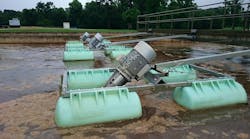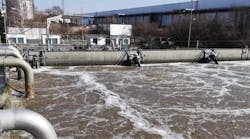Some water consumers live in areas in which municipal water is not available. They must rely on private wells for their water supplies. However, this water requires the same treatment for microorganisms, minerals and other contaminants to be safe for consumption. While the U.S. Environmental Protection Agency (EPA) regulates municipal public drinking water, it does not have the authority to regulate private wells. According to the EPA website (www.epa.gov), approximately 15 percent of Americans rely on their own private drinking water supplies, and these supplies are not subject to EPA standards. How can private well owners ensure they have a safe and aesthetically pleasing well water supply?
Well water treatment challenges
According to Marc DeBrum, assistant sales manager and applications engineer for ClearWater Tech LLC, water treatment professionals should to be aware of some private well challenges that depend on whether the well is for a single family residence or for a small gated community. Each well water source can present different water quality challenges.
"Drilling a well can cost thousands of dollars, and the unfortunate circumstance is that homeowner(s) are at the mercy of what the well provides, no matter the contamination load," says DeBrum.
Since most homeowners usually cannot afford to drill a new well in the hopes of a better option, they are forced to work with what they have.
Rarely, some wells may be pristine with no contaminants, while others may experience common offenders such as iron, manganese, hydrogen sulfide (a rotten-egg smell) and/or bacteria and viruses (usually tested as a coliform count).
Phil Jones, CChem MRSC, CWS-VI, product manager for VIQUA, says the "combination of problematical water constituents [include] water hardness, iron, manganese and sulfur odor — sometimes termed ‘aesthetic’ issues. A serious concern is microbiological contamination, which could comprise bacteria, viruses, and/or parasites (cryptosporidium or giardia), depending on source of [the] intrusion."
DeBrum states that the causes of well water contamination (iron and manganese) are often from minerals within the layers of the Earth as surface water filters through to underground aquifers.
"Hydrogen sulfide is created in wells by aerobic bacteria that feed off sulfate and sulfur found in decaying plant material," DeBrum says. "A failed sanitary seal on the wellhead can create an opportunity for contamination via insects and rodents. Holding tanks are typically ambient and therefore open to airborne contamination from mold, insects and even bacteria."
Sanitation and aesthetic solutions
Several solutions are available to correct the diverse aesthetic and more serious sanitary contaminants.
For aesthetic issues, Jones recommends water softening for hardness and traces of iron and/or sulfur and oxidation/removal systems for higher levels of iron/manganese/sulfur, says Jones. "Special media, ‘sanitizer’ systems [are available] for combined hardness and higher levels of iron/manganese."
According to Jones, regarding microbiological concerns, chlorination of the well or in-house UV disinfection systems are viable options. DeBrum agrees but suggests some other options.
"Solutions range from dosing the water with high levels of chlorine to providing oxidation and sanitation of the water, to using a green-sand filter [that helps] remove some of the contaminants, to a UV sterilizer to reduce the microbial count" says DeBrum. "However, most of these do not … provide a single source of oxidation and disinfection. Ozone … [is an] oxidizer and disinfectant that is used for many large metropolitan water treatment [systems]."
These ozone systems can be scaled down to serve residential systems.
Some systems may solve more than one problem or may need to be used in combination because each technique has a set of pros and cons. According to Jones, water softeners involve salt and water use, but they are a practical solution for softening water. Oxidation systems for iron, manganese and sulfur treatment require no salt but do not address the hardness that is often associated with these contaminants.
"Sanitizer systems will address hardness in a single unit," Jones says, "while … treating/preventing any iron bacteria buildup in the treatment media, but salt usage is required."
DeBrum discusses some of the limitations and strengths of each treatment type. "When chlorine is used as the only form of oxidation … in well water, it can be very slow to react and may not [completely oxidize and sanitize] the water. Therefore, chlorine [may] leave behind disinfection byproducts that are not healthy such as trihalomethanes. Chlorine is better suited to be the final residual sanitizer in a holding tank to keep water fresh.
"Ozone’s all-in-one process … oxidizes iron, manganese, sulfur and other contaminants in the water, allowing them to precipitate out of solution so that they can then be mechanically removed by filtration. Key elements to ozone’s implementation are correct sizing, [system] design and proper installation."
Testing and confirming water safety
Before a system is designed and specified — and periodically during a well’s life — the water should be tested. Before system installation, the water’s contaminant load and disinfection/treatment requirements should be determined.
"The levels of aesthetic contaminants, such as hardness, generally do not fluctuate in an established well," Jones says, "so a one-time test is often sufficient unless the environment changes in some way that could affect the well or aquifer. However, the microbiological contamination situation … can and does change according to environmental influences, [such as] runoff, land use or septic drainage and leakage. Testing, at a minimum, should be carried out annually."
If a well repeatedly tests positive for contamination, a larger problem may exist. If simple disinfection is ineffective, other measures may need to be taken.
"If the issue is just microbial," DeBrum says, "then UV sterilization could be the answer. If the contaminant load is greater and combines organic and inorganic loads, then ozone [may be] the answer for the job."
Jones explains that repeated positive tests for microbiological contamination indicate recurring contamination for which adding chlorine to the well is not a permanent solution.
"Installing a UV disinfection system provides continuous protection, but steps should also be taken to identify the contamination source, e.g. leakage from a septic system, a break in the well casing or other means whereby surface runoff gains entry to the well."
Other considerations
When conducting an initial consultation with a client, water treatment professionals should discuss all the client’s issues. This discussion will help determine how a private well could best be treated to produce an effective and safe water supply. Some items to discuss, according to Jones, are:
- What is the pattern of well water use?
- Is it desired to drink well water?
- What are the visible contamination clues (lime scale buildup, orange or black staining, orange/brown "gel" build up in toilet cisterns)?
- What is the septic system’s integrity and age?
- Where is the well located with respect to the septic system and surrounding land (especially if the land is for agricultural activity)?
"The first step of any project is to determine the customers’ issues and understand what their water treatment goals are. Beyond the main contaminates…other water quality points to look for are the pH level, total dissolved solids, nitrite levels, color, odor and turbidity," DeBrum says.
All the issues discussed in this article may be problematic, aesthetically affecting the end user’s consumption and, more important, causing illness if microorganisms are present. Developing a relationship with clients and discussing all aspects of the well water and its contaminants will provide an effective solution for their water supplies.


